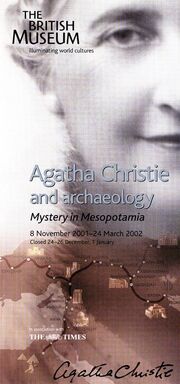
Agatha Christie and Archaeology was an exhibit held at the British Museum between 8 November 2001 and 24 March 2002. It presented a look at the secret life of one of the world's most popular writers.
- 'Many years ago, when I was once saying sadly to Max it was a pity I couldn't have taken up archaeology when I was a girl, so as to be more knowledgeable on the subject, he said, 'Don't you realize that at this moment you know more about prehistoric pottery than any woman in England?'
- A. Christie, An Autobiography (1981), p. 546
- 'Many years ago, when I was once saying sadly to Max it was a pity I couldn't have taken up archaeology when I was a girl, so as to be more knowledgeable on the subject, he said, 'Don't you realize that at this moment you know more about prehistoric pottery than any woman in England?'
From the museums own description of the exhibit
Agatha Christie originally became interested in archaeology on a visit to the site of Ur (in modern Iraq) in 1928. It was at Ur that she met her future husband, the archaeologist Max Mallowan, and became involved in excavation of the sites in Iraq and Syria that were to make his name.
Agatha was greatly devoted to her husband and his career, accompanying him on digs and fulfilling the role of junior assistant: cleaning and repairing objects, matching pottery fragments and cataloguing finds. She became very expert, and was much respected by Max's colleagues for her painstaking and skilled work. She also found time to write, and some of her best known books are based on her life in the Middle East: Murder on the Orient Express, Death on the Nile, Appointment with Death, and most particularly, Murder in Mesopotamia.
This tour looks at some of the objects from each of the sites that Agatha worked on, and some of the photographs that she made there, a unique record that captures the mood of the digs.
Review by Amy Lubelski
The following text is a review by Amy Lubelski published in Archaeology - A Publication of the Archaeological Institute of America in Volume 55 Number 2, March/April 2002.[1]
- The exhibition opens in the courtyard of the museum with a renovated car from that train de luxe, the Orient Express. Inside the museum, the exhibition continues with a certain hustle and bustle: a video with narration of Victoria Station, from which travelers to the Middle East left for France to board the Orient Express, plays continuously; mounted maps illustrate the train route to Baghdad; there is a display of 1930s fashion in suitcases--many designed by Louis Vuitton--with appropriate travel labels; and a panel describes Christie's desire to travel. Moving along, but more slowly, the viewer visits Ur with Christie, and we meet the Woolleys and Max.
- On display throughout are first editions of Christie's books with archaeological themes: Murder on the Orient Express (1934), which celebrates that fabled train; Murder in Mesopotamia (1936), in which Christie elaborates on her impressions of the Woolleys' excavation at Ur; Death on the Nile (1937), with its archaeologist villain; Appointment with Death (1938), set in Petra; and They Came to Baghdad (1951), where much of the action takes place on an excavation. Some of the covers were designed by Mallowan's architect, Robin Macartney. Cases display artifacts from the digs, and wall panels illustrate life on Mallowan's excavations at sites like Chagar Bazar, Tel Brak, and Nimrud. Christie always accompanied Mallowan on his excavations, making herself useful by photographing, cleaning, and recording finds; and restoring ceramics, which she especially enjoyed. One particularly charming panel describes how her face cream was used to clean the crevices on the many ivories they dug up. "There was such a run on my face cream that there was nothing left for my poor old face after a couple of weeks!" Christie wrote.
- As Christie and Mallowan worked less in the field, they wrote more. Photographs show them at work at the British School at Iraq, which Christie helped found, and their home in England. Mallowan was rewarded with a knighthood, which allowed Christie to be called Lady Mallowan. She was named a Dame of the British Empire; hence her title Dame Agatha. She preferred the former.
- One of the highlights of the exhibition is a copy of Come, Tell Me How You Live, the 1946 memoir in which Agatha Christie Mallowan described how enchanting life on these excavations had been for her. She wrote, "I am thinking...that it was a very happy way to live."
